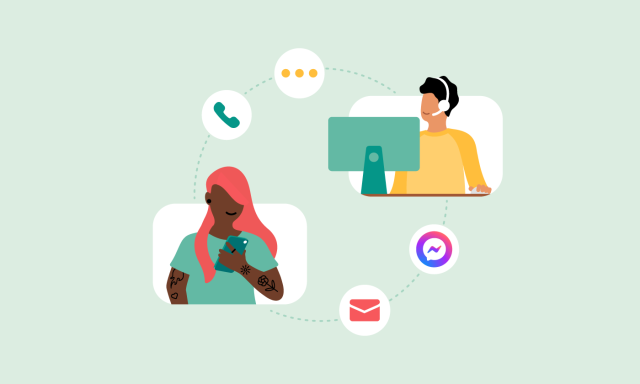In this article:
- What are customer engagement tools?
- 1. Self-service tools
- 2. Chatbots
- 3. Live chat
- 4. Voice calls
- 5. Video chat
- 6. Branded numbers and contact cards
- 7. SMS (short message service)
- 8. MMS (multimedia messaging service)
- 9. Surveys
- 10. Email
- 11. Push notifications
- 12. Social media engagement
- 13. iMessage
- 14. RCS (Rich communication services)
- 15. WhatsApp
- 16. Facebook Messenger
- 17. Instagram messaging
- 18. Telegram messaging
- 19. Viber messaging
- 20. Super-apps
- Unify customer engagement with Sinch
You know that old saying about how much more it costs to get a new customer than keep hold of one you’ve already got? It’s true. Luckily, businesses don’t have to choose one over the other. Why not have both? Customer engagement tools make it easier and more affordable than ever to hold on to existing clients and earn new ones.
Today’s customer engagement tools vary massively in terms of what they do and how they do it. There are many solutions to help businesses reach and talk to their customers in ways that weren’t possible even five years ago.
In this article, we’ll jump into some of the tools businesses use to interact in meaningful ways with customers. These tools are powerful, customizable, and, most importantly, already a part of customers’ everyday lives.
What are customer engagement tools?
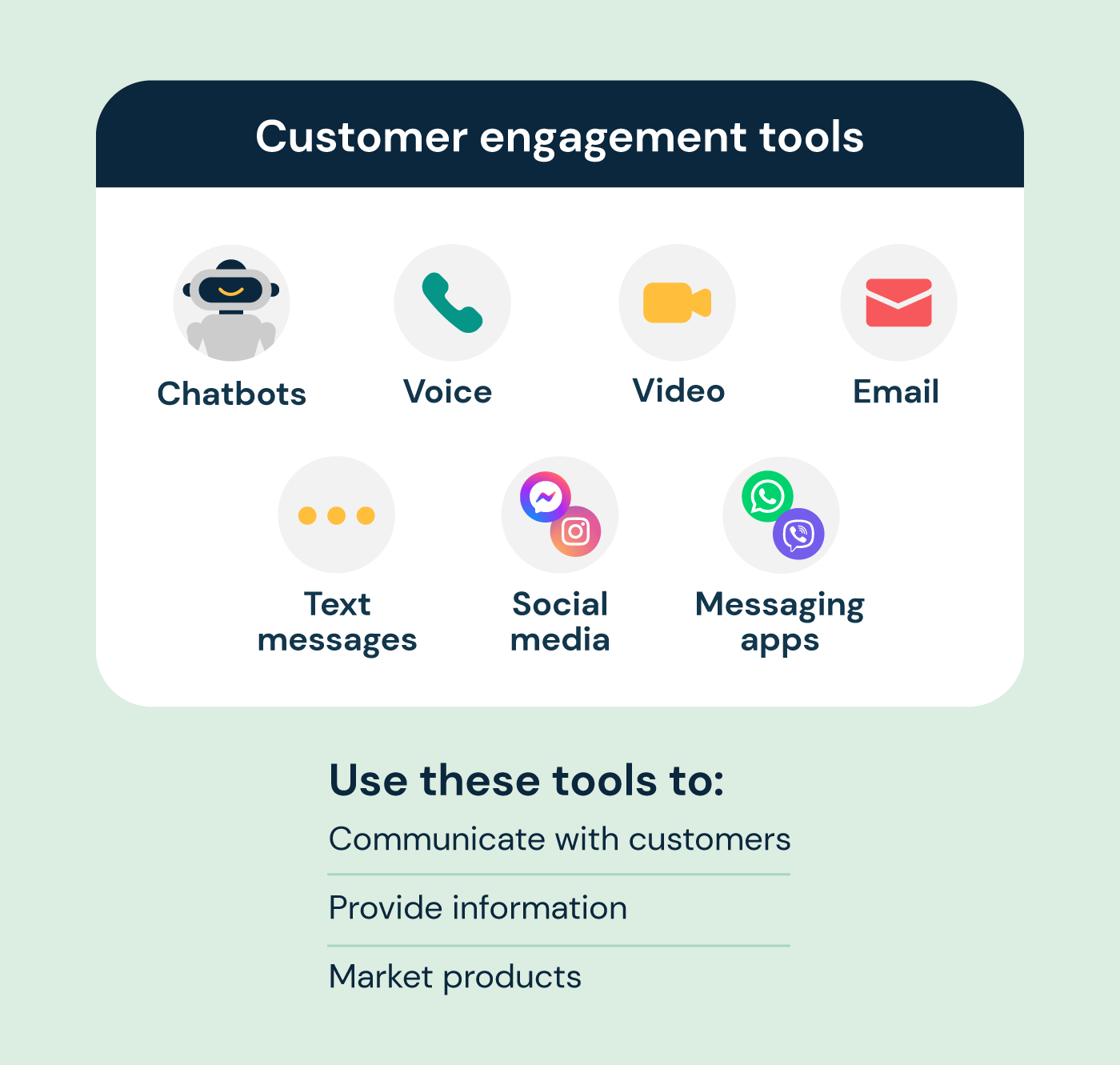
Customer engagement is the relationship businesses have with customers and how they work to maintain and improve it over time. Customer engagement tools allow businesses to talk to or serve customers. From sending a simple text message to building a chatbot, the right tools help make that connection.
Because there are so many different channels, any company that wants to thrive should go where its customers are. Using the channels their target audiences use daily, including social media channels, messaging apps, email, and voice services, can help build and maintain trust.
Engaging with customers in the ways they’re used to opens the door to learning more about them, including:
- Demographic information
- Preferred engagement method
- Sales funnel position
- Product and service preferences
Because this approach offers a seamless customer experience, we put a list together of the best customer engagement tools to build into a customer engagement strategy.
1. Self-service tools
What do you do when you’ve got a question about a product or service? You probably try to find the answer yourself. If a business has robust self-service tools, finding that answer shouldn’t take much time.
The most common self-service format is a knowledge base. Knowledge bases are online libraries with answers to frequently asked questions, product information, policies, and more. They’re easy to use and available 24/7.
Businesses can go further to help customers help themselves with product training. Product training can take many forms, including videos, web pages, and downloadable manuals.
One way to help a user find answers is by using a smart search solution like AskFrank. Because it integrates into your site, voice bots, and chatbots, its ability to understand natural language can provide better answers to searches.
To boost engagement when customers are looking for answers on an FAQ page or knowledge base is to add a “click to chat” icon. That gives them a chance to reach out easily if they aren’t finding exactly what they’re looking for.
2. Chatbots
Chatbots help people get personalized attention and answers without live agents having to deal with the most commonly asked questions. Chatbots can be customized to answer everything from FAQs and inventory inquiries to account-specific questions like the status of an order or when an appointment is. They also help reduce call volumes by answering common questions and providing updates.
Chatbots are powerful because they provide a bridge to customer support. By collecting a customer’s information and their questions, chatbots can route the conversation to the right live agent. The conversation with the chatbot is also shared with the live agent so they understand the context of the situation while also keeping the customer from having to repeat themselves.
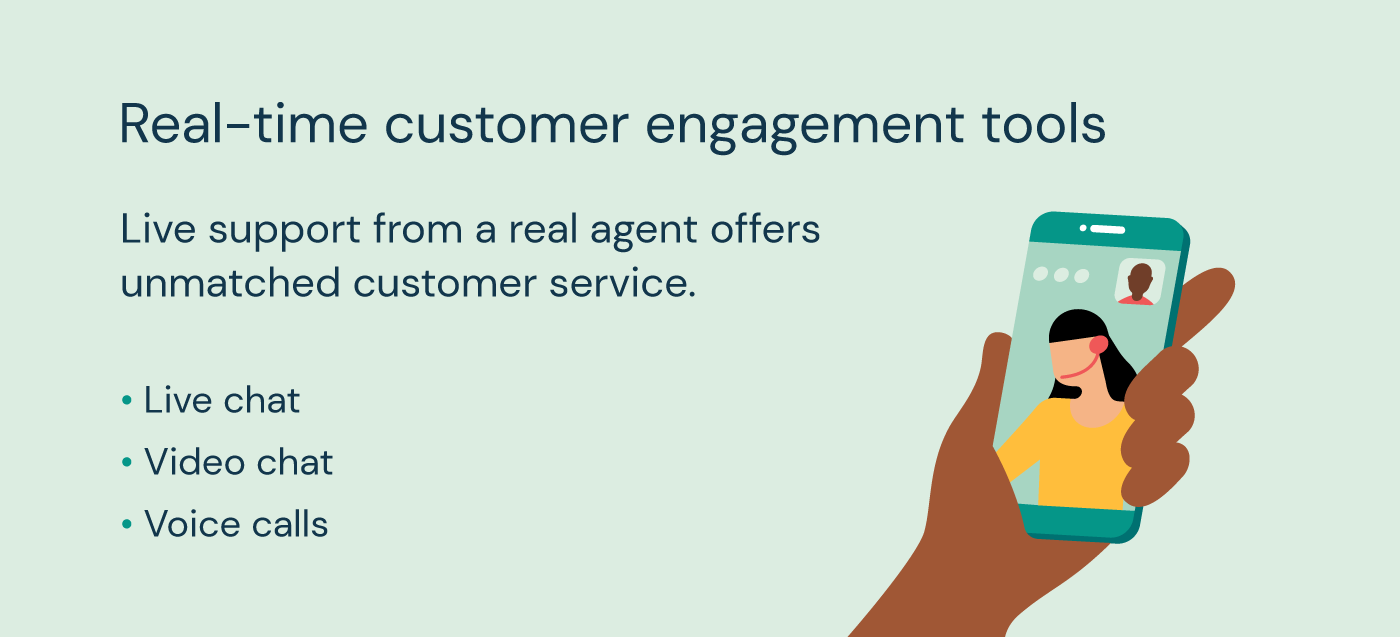
3. Live chat
Do you have live chat options for all of your messaging channels? If not, you’re going to want to start. Whether it’s on your website, company apps, social media channels, web chat, or dedicated chat applications, you need to be able to talk to customers on the channels they prefer.
With omnichannel capabilities and integrated chatbot support, you can create an uninterrupted flow of communication if or when a conversation moves from a chatbot to a live agent.
While it’s pretty easy to think of live chat as the last step in a customer’s troubleshooting or sales journey, it can make a huge difference for many customers at all stages in their experience with your brand.
With modern live chat systems, support agents can talk to customers in the moment of need, give updates on existing orders, or even offer personalized recommendations based on their previous interactions.
Having a live person on the other end of a chat could help beat the competition when it matters most.
4. Voice calls
While phone support and sales may be less popular than they used to be, don’t underestimate the power of a voice - it’s still a powerful customer engagement tool. Unlike in the past, dedicated, complicated, or expensive phone systems aren’t needed to talk to customers.
It’s now possible to have a voice call in several apps and platforms. In-app voice calls offer secure, high-quality calling that can scale with a business. Live engagement is a powerful tool that can do wonders for customer satisfaction.
5. Video chat
One of the biggest advantages that video chat offers is the ability of your agents to help customers solve problems without having to send someone to the customer’s location. This saves your customers time and it saves your company time and money. That’s an unbeatable combination.
For industries where face-to-face communication is a bedrock principle of how the service is delivered (healthcare, professional and financial consultations, exclusive shopping assistance), video chat makes it possible, even across large distances.
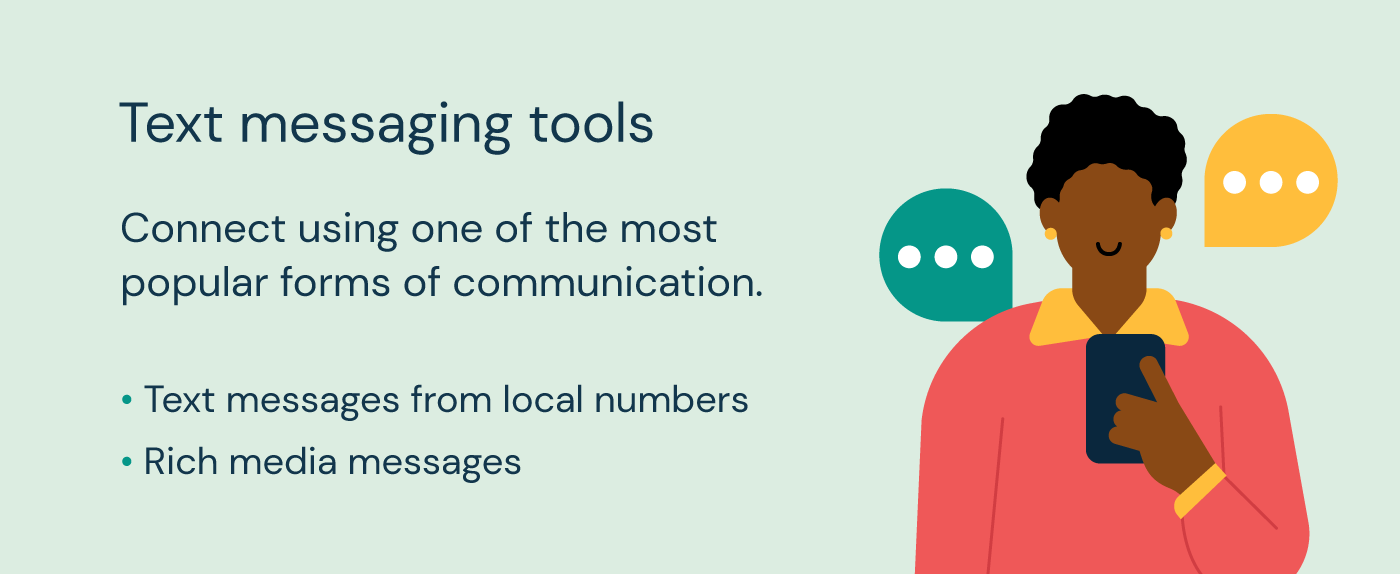
6. Branded numbers and contact cards
If you’re like most people, you probably didn’t answer the last time you received a call or text from a number you didn’t know. Even as the world becomes more global, people are more likely to trust (and answer) local numbers.
A dedicated number offers the chance to engage with customers using SMS, MMS, and voice - all from one number they trust.
A business’s own number keeps messages flowing since they’re the only ones using it. A dedicated 10DLC makes it easier to comply with all applicable laws since it’s not shared with anyone else.
To further enhance brand recognition, engagement, and trust, you can also create a company vCard — i.e. a Virtual Business Card — and share it with your customers via SMS. Once saved onto their devices, a vCard allows you to communicate in a branded environment. That means your name and logo will appear on your customers' screens every time you text them — and it works for phone calls, too! Bonus: They'll also have all your company information at their fingertips.
7. SMS (short message service)
What’s the biggest messaging channel that’s already available on every mobile phone in the world and has billions of users? Text messaging! SMS is global, fast, and engaging at a rate that other engagement tools can only dream of. Studies have shown that 90% of people open their texts within three minutes!
Even the most basic text-only SMS messaging enjoys near-universal adoption.
If businesses want to connect with customers on one of their most-trusted channels, SMS messaging is a must. Make sure messages are delivered with an SMS API - it makes marketing and support easy while remaining compliant.
Take advantage of the power and security of SMS with alerts, one-time PINs, and two-way chat.
8. MMS (multimedia messaging service)
Think of MMS (Multimedia Messaging Service) as the midpoint between SMS and rich communication services. Where SMS texts have a limit of 160 characters, MMS texts can send up to 5,000 characters along with videos, GIFs, images, and audio.
MMS is great for marketing and support programs because it creates a richer experience for customers while boosting overall customer engagement. Great MMS systems optimize messages per device - so they always look their best. And, if an MMS message fails, an SMS with a dynamic URL will be sent instead.
9. Surveys
Learning more about clients is how businesses make smart decisions on where to go. But how do you know if the information you have is accurate? Simple - ask them!
You can even deliver surveys using a chatbot on whichever channel a customer prefers. This creates a more active, conversational experience where the customer is asked questions one at a time instead of having them scroll through questions on a page.
Sending surveys directly to customers as a part of a customer engagement platform gives real-time information and decent sample sizes. Use the data to help improve products, marketing efforts, and more.
Also, customers like filling out surveys - it shows a brand cares about their opinion. It builds trust, which can be hard to earn in other ways. Surveys are one of the most helpful user engagement tools a business should take advantage of.
10. Email
There’s a reason that email is one of the go-to customer engagement tools: It works. Email is especially effective when you want to deliver on-brand content to large groups of people.
Use email for:
- Newsletters
- Promotional offers
- Marketing campaigns
- Notifications, including password changes and delivery notifications
Modern email systems make setting up and scaling easy while giving you everything you need to reliably deliver customizable content at a low cost.
11. Push notifications
Got a last-minute sale to announce? Want to remind a customer about an appointment? What’s one of the fastest and easiest ways to deliver the message? A push notification. For existing customers who are already using your app on their mobile devices, notifications get you right on their home screen.
Studies have shown that push notifications have a 50% higher open rate compared to email and they have a click-through rate that is 7 times higher than email. Here’s the cherry on top – 70% of people find push notifications useful.
12. Social media engagement
Having a solid social media presence is about more than just posting content - it’s about giving people new ways to interact with a brand, whether they’re already loyal customers or just learning what a business does.
Each social network’s messaging is different, so it’s critical to use a system that works across all platforms. The right social media messaging API will offer plenty of flexibility and features, including two-way messaging and rich media messaging.
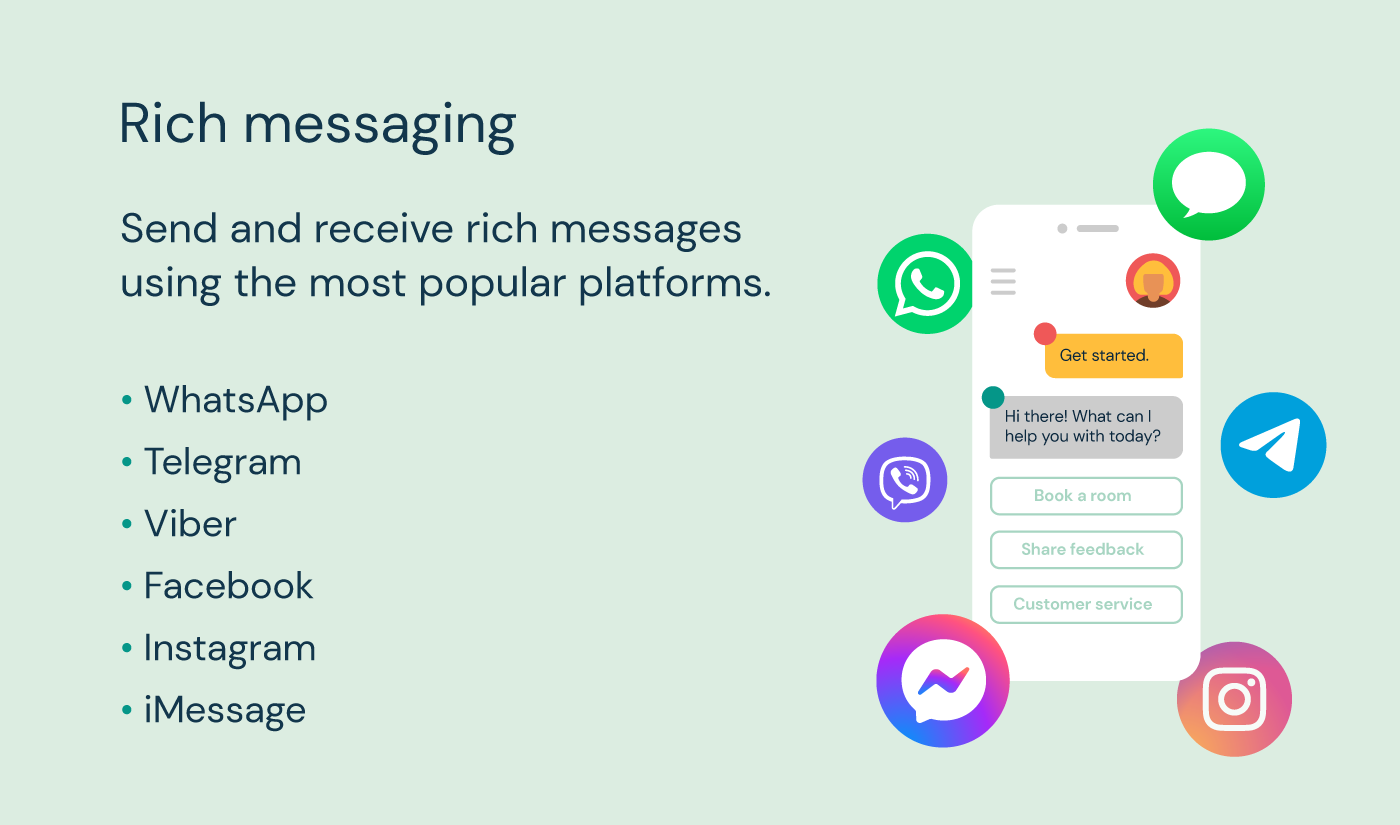
13. iMessage
Customer engagement solutions don’t mean building something from scratch. Using the channels customers are already on means better engagement and adoption.
iMessage is one of the most popular messaging apps (it’s already installed on over 1 billion Apple devices) and Apple Messages For Business is a service Apple provides that lets businesses communicate with their customers through iMessage. Customize how conversations look in the app, simplify transactions, and provide customer support.
Choose an official Message Service Provider for Apple Messages for Business to access all the tools!
14. RCS (Rich communication services)
Think about the last chat message you received from a business. Do you remember it? Probably not - unless it was enhanced with rich media features.
RCS messages are Android-only messages enhanced with interactive features to mimic an in-app messaging experience. This can include action buttons, videos, and more delivered directly to a customer’s native inbox app with no app download needed.
RCS is only available to verified businesses, so customers can trust that messages are genuine. RCS can also be tailored using customer data to match where they are in the sales or support funnel.
15. WhatsApp
A chat app with over 2 billion users? That's WhatsApp! Create automated chats on the world’s most popular messaging app to improve reach or offer real-time, live customer support. You can also run marketing campaigns on WhatsApp to reach your customers on a platform they’re already using.
16. Facebook Messenger
Messenger, the spin-out messaging app from Facebook, boasts more than 1 billion users across the globe, so it’s essential to get messaging on point.
In addition to helping answer questions and engage with customers, Facebook messaging can link directly to a website or store for easy checkout or support.
17. Instagram messaging
Instagram’s 1 billion monthly users, especially users in the 20-35 age range, are ready to learn more about brands and get top-class customer care through the app.
Build a brand identity on Instagram and get set for perfect conversational commerce - relaxed, meaningful interactions that are the basis for long-lasting relationships.
Integrate chatbots for always-on customer service and link it with other engagement tools so agents are ready to help, too. Powerful Instagram customer engagement tools allow everything from answering pre-sale questions, providing customer support, and responding to customer feedback.
18. Telegram messaging
With 40% growth year on year, Telegram is one of the most exciting and powerful channels a business can use to improve customer engagement in targeted geographies. Telegram is secure, which is important to its younger user base - and great for businesses.
Because business messaging on Telegram is user-initiated, there’s more action here than on any other channel. Integrating chatbots for FAQs along with live agents allows for unmatched support. Stay connected with customers via promos, updates, and newsletters right in the Telegram app.
19. Viber messaging
Integrate with Viber to use chatbots, automated responses, and two-way communication in a branded environment. If your company is working in one of the 200 countries where Viber is most popular, you’ll have access to almost a billion users. With Viber, you have the opportunity to talk to customers using their favored channels.
Viber allows for rich elements like files, images, and CTA buttons that traditional SMS doesn’t offer. Find a Viber Business Messaging partner to provide the best options for using this platform.
20. Super-apps
If you’re doing business in Thailand, Taiwan, Japan, China, or South Korea, you need to be interacting with customers using super-apps. WeChat, KakaoTalk, and LINE, combine tons of services into one place, including booking vacations, shopping online, and ordering taxis.
It’s possible to communicate with customers using these super-apps using Conversation API. These apps also give you the chance to send marketing materials and notifications so you’re there at every step of a customer’s journey.
Unify customer engagement with Sinch
The number of customer engagement tools is growing every day. But that doesn’t have to be stressful.
It’s possible (and simple) to centralize and manage customer engagement with tools from Sinch. Using powerful, cutting-edge APIs, an omnichannel customer engagement system is easily within reach.
Get in touch today to unify messaging across channels, provide better support, and gain better insights into customers and their habits!
